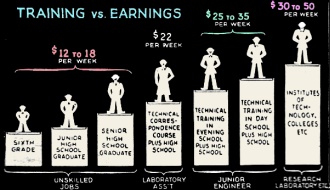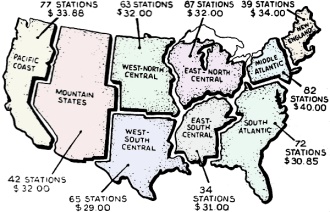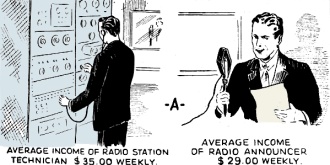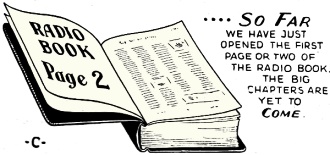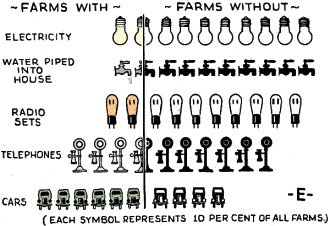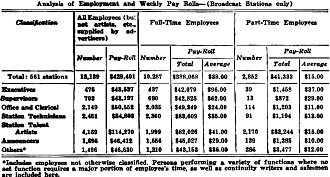A Key to Radio as a Vocation
|
|
In 1936, a high school graduate could expect to earn about $15 per week, or about 38¢ per hour (40−hour week), in the radio business. According to the U.S. Bureau of Labor Statistics' Inflation Calculator, that is the equivalent of around $329 per week in 2023, which is not much to live on these days. Today, many McDonalds burger flippers are being paid $15 per hour ($600/40−hour week). That equates to a little over $27 per week in 1936 - nearly twice as much as an electronics technician who likely has military and/or technical school training. This 1936 Radio−Craft magazine article discusses the benefits of formal education in regard to potential earnings in the nascent radio business in many roles ranging from maintenance technician to broadcaster to management. The principle generally holds today. BTW, note the percentage of farms without commercial AC electric service. A Key to Radio as a VocationHave you considered your future in radio? What chance have you to succeed - what method of procedure will yield. the best results? The answers are given below. W. E. Schrage Attracted to some extent by the glamorous fame of the few big money-makers in the broadcasting field, thousands of young people concentrate their hopes and thoughts upon the radio industry as the future realm of their vocational careers. A number of them dream of jobs as announcers or as artists in front of a nation-wide audience. However, it is not this group in which we are interested. Instead, our concern is with those who concentrate their thoughts upon the design or construction of transmitters and receivers, or upon research in one of the nation's leading laboratories - it is these whom we should like to guide through the labyrinth of the professional market, today. A Chance for Amateurs An interesting feature about the American radio industry is the fact that a considerable number of the most successful men in this industry are former amateurs, and it seems that a consideration of radio as the future career for a radio amateur is not a bad idea, because it gives him a chance to utilize valuable experience acquired from his hobby. It is certainly more sensible than to start a vocational trip in "terra incognita," i.e., to go into an industry where lack of fundamental knowledge of this industry makes it necessary to begin at the first step in the .long stairway of experience collecting. But this is not the only reason why a radio career seems to be a desirable one for the young radio amateur seeking a way to make good. The Grecian philosopher Plutarch said, some 2,000 years .ago: "A man's felicity consists not in the outward and visible favors and blessings of fortune, but in the inward and unseen perfections and riches of the mind." This statement, full of wisdom .and knowledge of human nature, still hits the mark after all this time. However, and this is of great importance in today's world of dollars and cents - the radio industry is not only the realm for a young man who seeks "beauty of soul" but it provides at least as many chances as any other industry for the "right" man to make good. Fig. 2 - The balance of education against income. Fig. 3 - National breakdown of technicians' average weekly income. But: "Who e , the right man?" Not the one who likes to play around a little bit with radio, because all his friends do the same, but the one with inborn technical abilities, re-enforced by proper training. Playboys, who go about the matter of radio somewhat similar to the housewife who lets the family starve if either the cookbook or the can opener gets lost, have little chance to make money, because creation and not reconstruction is the key to success. This leads us to a discussion of the "nervus rerum," to the never expiring question of money. How much money can a young man with ability and deeper interest make in the radio field if he chooses it as his vocation? This question must be answered by means of another question: "What kind of training does this young man in question have?" The importance of proper training for a successful career in radio's realm is shown quite impressively by Fig. 1. We see at the left side an unskilled laborer who "graduated" from the sixth grade of elementary school, and who would be better out of the radio industry since a person of his class has but little chance without additional training. He may eventually get a $12- or $14-a-week job on a factory assembly line, but he would do much better by going into the shipping department of the company, or somewhere else where unskilled labor is much better paid, than in the price-slashing atmosphere of the radio industry. This does not mean that even such a "graduate" can't become the executive of a large business. It is, of course, quite difficult, but the history of American industry contains inspiring examples of hundreds of insufficiently educated men who did very well. It was, though, and still is, an infinitely torturous task to succeed in this way, and the few examples of brilliant careers are by far overbalanced by the hundreds, and even thousands who did not reach their aim. The history of our industry, however, seldom tells about their wasted struggles and starvation. Successful careers of graduates of the 6th grade elementary school, on the other hand, are even possible today. Remember, too, that there is always plenty of room at the top for men with real ability. No one is born too late: who is to go to fill the big jobs in the big companies when the big men who are filling them now are out of the picture? But, the chances are very poor for the man who trembles each time he is confronted with an application blank because he must bare the fact that he has but a limited school training. I must also disappoint even those who graduated from junior high school, and in fact a great many who are graduated from senior high school, because they are also classified under "unskilled labor" when they must admit to being without additional training. There are, at present, thousands of high-school graduates who work on the assembly lines of American radio factories, and make not more than $18 weekly, which is, according to the statistics of the Radio Manufacturers Association, the average income of workers of this 'industry!" How to Enlarge a $18-Per-Week Income Now let's take the case of a nice fellow who has not had the opportunity to attend the evening course of an accredited technical school. What is he going to do? There are many correspondence schools, and in addition there are many excellent public libraries all over the country. If he learns enough about radio technique by this method of vocational education eventually he may become a laboratory assistant, a job which is not only better paid, but one which also opens for him the road to the top, since if he has the chance to work in such a .place, he may have an opportunity to .show his real qualities and abilities. However it takes a man with a good brain and great ambition to succeed in this way. Vocational Education Makes the Road Smooth A more promising method in building the road too successful career is by attending the evening or daytime courses in a technical school, or study courses of technical correspondence schools of good reputation (such as Coyne Electrical School, National Radio Institute, R.C.A. Institutes, Inc. and Sprayberry Academy of Radio. -Editor). Such a training entitles the man to a job as junior engineer which means about $25 per week - and even more in a relatively short time, if the man in question has special qualities. Of course, graduates from reputed schools of technology, as for example: M.I.T., etc., have the best chances. However, an education of this kind means quite a financial investment. In some, it involves a study consisting of years in elementary school, 4 years in high school, and an additional 4 years in a college or an institute of technology. (As stated, in more detail, in the November, 1935, issue of Radio-Craft. -Editor.) To just what extent this investment may be advisable in each specific case is difficult to decide, since a great many of the leading men in the American radio industry obtained their positions without such "intensive" training. On the other hand, about 80 per cent of the rank and file of the great staff of the Bell Telephone Laboratories are graduates from universities, institutes of technology or similar institutions. Abilities Determine Success Getting down to brass tacks, the success of men with or without academic training depends on other facts than just scholarly wisdom. It depends on faculties which no one can learn, but which are inborn, as for example the ability "to see problems" - that is, "to analyze the factors involved," "to arrive objectively and without prejudice at solutions"; and, last but not least - "to convert their ideas into designs of practical value;" (see Fig. 2). In addition to these abilities and qualities these men must have "aspects of leadership," and this is the kind of men the American industry is looking for. But as Mr. Samuel S. Board, the placement specialist states in a pamphlet, published by the American Society of Mechanical Engineers: "The demand for such men is greater than the supply"! And Mr. Board, an authority in this field, knows what he is talking about. Women in the Radio Industry Another point of interest in a discussion of chances for a career in the radio industry are the vocational opportunities for women in this professional line. One would think that the radio industry would offer great possibilities for women, because today the radio set is just a common piece of household equipment. Knowing that women are credited with spending 80 cents out of every dollar, one would expect to find women employed in research laboratories to give radio sets the "woman's touch." It is true that there are at present thousands of women employed on the assembly lines of American tube and set factories, but no case is known to the author where a woman has an important position in a radio laboratory. There are, of course, a few women radio operators known, and some women designers who cooperate as free-lancers with radio-cabinet factories, but this seems to be all that can be said at- present about women in the radio industry. It is of interest that women broke into the radio profession as radio operators, because the job of radio operator is not only an interesting, but also a responsible one. Careers for the Men-Folk There are also a great many young men who are interested in radio operating as a career, despite the fact that this profession is not as highly paid as many believe (the recent strikes of radio operators indicate this clearly). However, there must be something attractive in this career because the U. S. Census counts 5,000 employed in the various land stations, and aboard American ships. About 2,300 men have found employment as technicians in connection with the American broadcasting stations. What these men earn, and how their incomes compare with other employees working in the broadcast industry, are figures that have recently been compiled in the form of a regular census by Mr. C. H. Sandage, of the U. S. Bureau of Commerce. The census is as yet not completed because of the 564 broadcasting stations covered by the census, only 561 cooperated with the Bureau. These stations employ 14,561 persons with an annual payroll of $26,911,392. The average income of broadcast technicians varies according to the location, but before we give the facts about the higher salaries paid in certain parts of the country, we will present some surprising facts. We will then find that the glamorous fame which surrounds the radio artists and radio announcers is, as far as salaries are concerned, absolutely unjustified. The average income of a radio technician, doing his duty in plain overalls, exceeds by far the average income of the announcers who speak daily to millions. According to the U. S. Census, an announcer gets on the average $29 weekly, but the average income of a station technician is $35. (See Fig. 4A.) The artists employed by the broadcasting stations receive, on the average, a weekly income amounting to 841. The income of the nationally-known artists, who are employed mostly by advertisers ("commercial sponsors") are of course not included in this compilation, since they are paid directly by the advertisers. Additional details which will do away with many of the tales about the salaries paid by the stations are given in Table 1. There is one exception to .be considered, these figures do not concern the weekly average income of the persons employed by the great networks. Network technicians receive on the average $60 weekly, and only network announcers who have an average income of $91 exceed with their salary the income of the technicians. What Regions Pay Technicians Best? And now to the regional tips in regard to the best salaries paid. To make the story simple. all facts concerning this very important question have been combined into a map (see Fig. 3) which shows the average salaries paid to radio technicians in various parts of the country. The best salaries, we find, are paid in the Middle Atlantic States, and amount to $40. A careful study of the map under consideration showing the different living expenses in each section may provide some interesting facts for job seekers. Is it possible, then, that the "big money" may lie elsewhere than in radio, per se? Let us look further into the story. Power Companies are the Big Money Makers In a series of 8 broadcasts during February, 1936, the Columbia Broadcast System presented interviews with 8 Americans having widely different points of view and interest, and asked them for their opinions concerning some of today's important problems in broadcast control. Among the persons interviewed was Dr. Orestes Caldwell, one of the original members of the Federal Radio Commission. Among other things, concerning American Broadcasting, he stated the following interesting facts: "The big money in broadcasting goes to the electric light companies. In fact; they collect 2 dollars for every dollar earned by the artists, the broadcasting stations and the networks, combined." (See Fig. 4B). "For the operation of radio sets alone, the utilities companies collect about 150 million dollars yearly. This is about twice the entire amount that it takes to operate all the broadcast stations, the chains and the networks in the U. S." Dr. Caldwell suggested that the power companies should pay the entire cost for the present superb programs, and they would still enjoy a net increase in income of about 70 million dollars per year. In connection with the interview quoted above, Dr. Caldwell, who is one of the leading authorities on broadcasting, made the following pithy remarks about the future of the radio field, which will show, much better than all our detailed summaries could do, what one might reasonably expect, to find upon going into the radio industry as a career. He said: "This thing we call 'radio' is just beginning. With Broadcasting and Communication thus far we have just opened the first page or two of the radio book. The big chapters are all yet to come." (See Fig. 4C). "Ahead of us is the vast empire of the Short Waves, and the Ultra-Short Waves with their hundreds of thousands of channels. Ahead of us, too, is Facsimile - the delivery out of the radio set, of a little printed newspaper right in your home. And Television is on the way. And there's Wired Broadcasting over the electric wires, and over the telephone wires, both new in experimental operation over considerable areas. "We'll have plenty of broadcasting of one kind or other to give all the free speech that anyone wants." Although these sidetracks in the application of radio are often of considerable commercial value, if we compare them with the business possibilities in the broadcast field still waiting to be utilized, the comparison will be in favor of the broadcast field. Statistics Up-to-Date There are about 22,500,000 passenger cars registered in the U. S., but only 2.400,000 cars are as yet equipped with receivers (see Fig. 4D). The American radio industry sold, during 1935, 350,000 battery-operated receivers, but according to a survey made by the Rural Electrification Administration, 80 per cent of all farms are still without radio (see Fig. 4E). According to statistics published by the Joint Committee On Radio Research, there are at present 25,000,000 radio receivers in use in the U. S. More than 50 per cent of these are quite obsolete and the number, which should be replaced by new models, grows each year. The total number of sets manufactured in 1935 was about 5,350,000, but about 67.9 per cent of the receivers sold to the American public were replacement sales. Estimates of the total production for 1936 give as a production mark, the large number - 6,000,000 radio receivers. Obsolescence in radio sets is a kind of "life insurance" for the radio industry, since each day more sets become old fashioned, and each day thousands of new families become enthusiastic radio listeners. Radio is still a young industry offering great possibilities. Take your share out of the radio bag.
Posted December 20, 2023 |
|

